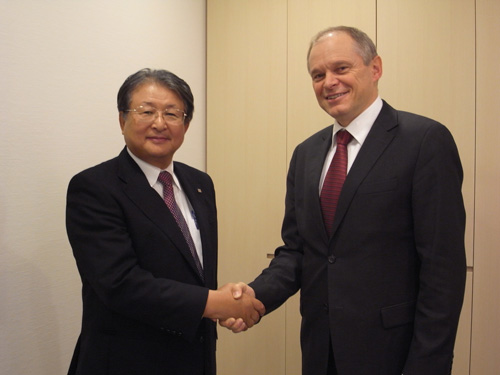[Special commentary on the news that Heidelberg and Ricoh announce global strategic cooperation]
When Bernhard Schreier, the Chairman and CEO of Heidelberg Druckmaschinen AG announced at IPEX last year that Heidelberg would be re-entering the digital printing market through an alliance with a partner organization, I felt somewhat apprehensive as to just what sort of agreement this would be, or even if such an agreement on Heidelberg's terms would be possible. I know that I, and many others in the analyst community were somewhat dubious if such an agreement would be possible with a suitable partner, and also if Heidelberg really understood the digital market they planned to re-enter.
Mr. Shiro Kondo (left), Ricoh CEO and Mr. Bernhard Schreier (right), Heidelberg CEO

One has to look back at the previous time that Heidelberg was in the digital market. This was when they partnered with Kodak to develop the Nexpress. Heidelberg brought its knowledge of offset printing and heavy engineering and produced the Nexpress 2100 that utilized imaging and toner technology from Kodak in a printing platform developed and engineered by Heidelberg. While the Nexpress was a great imaging engine it was greatly over engineered with a manufacturing cost that was around the targeted planned sales price. The product also did not fit the needs of the market in that it could not connect to inline finishing systems nor could it run more than one substrate at a time. It was not suited to the traditional Heidelberg customer in being too expensive and with too great a duty cycle. It was in fact a typical engineering driven rather than market driven product. Since the product was taken over by Kodak they have rectified through re-engineering most of the initial problems with the Nexpress, and it is now a highly competitive product line.
I was therefore delighted to find that Heidelberg's re-entry into digital printing is via a market driven approach. The company has carried out a major amount of research into the commercial printing market and has looked at all the different segments of the market to ascertain the area where it is most likely to succeed in providing a suitable package for the substantial Heidelberg worldwide user base. In this it is not going head to head in the "professional" or "high-volume" digital markets, nor does it plan to compete in the highly competitive office market. The market Heidelberg is targeting is the "Value" segment of the market. This is the area where digital presses would have a speed from 60 up to 90 A4/Letter pages per minute with a monthly target volume between 80,000 up to 300,000 pages/month or even more and with a price of €100,000. This market therefore does not include the presses from HP Indigo, the Xerox iGen4 and 800/1000 presses, the Canon ImagePress 7010, and the Kodak Nexpress and Xeikon presses.
Heidelberg's requirements in entering this market are for the press to conform to the Value segment specification, but also to have a quality that is the equivalent of that available in four-color offset and "Performance" digital printing segment. The other unique selling point of the Heidelberg digital printing offering is that while the press may be sold separately, it is ideally configured as a package with the Heidelberg Speedmaster 52 Anicolor short run offset press. Both presses would be driven from the same color management system to give comparable color output. Heidelberg has analyzed the short run color market and found that the true economics of digital printing show a crossover point of digital and the Anicolor at around 200 - 300 pages. They see that when both the digital and Anicolor presses are driven from the same Prinect workflow system that the true economics of every job can be ascertained prior to printing, allowing the printing company to choose the best system for the job.
Now this may sound all very good but how will it work in reality. Well I think it is the ideal solution for the small and medium sized printer entering the digital field and is in fact something I have been suggesting for many years. A key factor however in this is quality and can the digital and offset presses give the same quality of work. With a few exceptions, such as working with some special substrates, they can. The work I have seen produced off the Heidelberg digital press during an analyst meeting end of December 2010 was exceptional and I could not easily tell the difference with offset printing. What was also significant was I could not tell the difference between the Heidelberg digital press output and from the same output produced by an HP Indigo customer on one of the latest HP Indigo presses. This is the press that is that has set the standard for digital printing quality and which cost three to four times the cost of the Heidelberg press while having a lower pages per minute output.
Ricoh Pro C901 Graphic Arts Edition

I think Heidelberg in choosing Ricoh as its partner for re-entry into the digital printing business has been a very astute and excellent decision. The Ricoh C901 Graphic Arts Edition press is an excellent press that is really challenging the established players in the market for both speed and quality. While Ricoh has a great distribution channel into the enterprise and office markets for both sheet fed and continuous feed printers and presses, it has a limited presence in commercial printing. This provides a great opportunity for Heidelberg to use its worldwide distribution as the leading supplier in the commercial printing industry to really establish itself as a key digital player. Heidelberg will also move slowly into the market as it develops its expertise and offerings. It is not aiming at the specialized personalization markets of sophisticated direct mail leaving these to other suppliers, but it will no doubt offer software to allow its customers to handle personalization of output. Initially it will partner with Ricoh for service while it builds up expertise in key markets. It will however adopt the usual digital printing practice of click charging for prints, and will provide Saphira toner for the presses.
The agreement with Ricoh should not however just be looked at for just the initial offering. Heidelberg and Ricoh see this as a long term partnering agreement where Heidelberg will work with Ricoh on the development of future presses to expand the product range, perhaps incorporating Heidelberg's expertise in paper handling and color control. One must also look ahead to think what may happen. Ricoh is a key player through Ricoh Infoprint in the high-speed continuous feed market. This currently uses the Screen Truepress Jet520 engines, but one must expect that Ricoh, through its Hitachi Printing Systems division is developing its own inkjet print engines. I could envisage that such engines could be sold through Heidelberg into the graphic arts markets for publishing applications. One must also look at what Heidelberg could do for Ricoh. Heidelberg is a leading supplier of finishing systems for commercial printing, but makes nothing at this stage for digital print finishing. I could see that if Heidelberg moves into continuous feed inkjet printing with Ricoh that it could become a key supplier of finishing systems for this market.
While the big news is that Heidelberg is making a major move to re-establish itself in the commercial digital printing market, one must not forget that the company is already operating in the continuous feed inkjet market through its Linoprint division. This provides specialized systems for packaging applications using UV curable inks. There are plans to expand the Linoprint product line to possibly move into other areas, and this would expand Heidelberg's role in digital printing.
Overall I am pleased to say I have been delighted to see the change in role of Heidelberg, to switch from being an engineering driven company to a market driven company. I like the strategy they are adopting and think the partnership with Ricoh gives them great opportunities for the future. I think that it shows that offset and digital printing work together, and that offset has a major part to play in the future of the industry.










Discussion
By Cary Sherburne on Feb 23, 2011
Keep in mind also the recent partnership Heidelberg announced with EFI to sell its VUTEk superwide format printers. The difference here, of course, lies not only in the applications suitable for the VUTEk presses (very different from the Ricoh capabilities), but also in the fact that a VUTEk press carries a price tag in the range of many of the Heidelberg presses, perhaps incenting Heidelberg sales reps to seriously sell this product and to work with customers to add the new services enabled by superwide format printing to their portfolio of offerings. We certainly will be interested in following the outcomes Heidelberg is able to achieve with this digital portfolio and the impact it has in the long term on the company's financial position.
By Dwight Polglaze on Feb 23, 2011
Nice piece, Andy. Thank you.
This is definitely an exciting announcement--many of us have been waiting to hear who, what and when. Two points on this are worth adding to: First, the fact that both engines will be run from the same Prinect system is just common sense—at least it is to me. Genius would be running multiple engines from the SAME controller or developing a managing server like Fiery Central. Second, if they are going at this from a truly market-driven vision, then I wonder why VDP is not being discussed more.
Will Ricoh and/or Heidelberg be doing anything special at On Demand related to this announcement? What about GraphExpo?
By Chuck Gehman on Feb 24, 2011
I don't get it.
By Thomas Bougher on Feb 24, 2011
Just curious here. No one has commented how this will effect IKON.
Any thoughts?
By Tony Karg on Feb 24, 2011
Andy, great update and insight. Thank you. Did either of these companies tap into your expertise or will they utilize your consulting services to help develop their go to market strategies?
By Andrew Tribute on Feb 24, 2011
Hello Tony
Neither company tapped into my "expertise" although when I was briefed on the basic ideas in December before any partner was chosen and an agreement was finalised, I felt it was almost a consultancy session. As far as will they utilize my consulting services to develop their go to market strategies? - well I am available should they feel they need it.
By Andrew Tribute on Feb 25, 2011
Hello Tony
Neither company tapped into my "expertise" although when I was briefed on the basic ideas in December before any partner was chosen and an agreement was finalised, I felt it was almost a consultancy session. As far as will they utilize my consulting services to develop their go to market strategies? - well I am available should they feel they need it.
Discussion
Join the discussion Sign In or Become a Member, doing so is simple and free